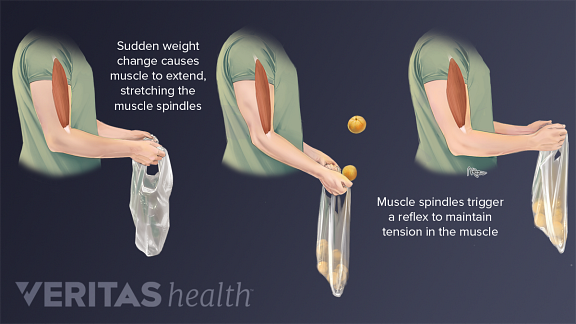Proprioception: Making Sense of Body Position
For upon|Proprioception refers to the body’s ability to perceive its own position in space. For example, proprioception enables a person to close their eyes and touch their nose with their index finger.
Other examples of proprioception include:
- Knowing whether feet are on soft grass or hard cement without looking (even while wearing shoes)
- Balancing on one leg
- Throwing a ball without having to look at the throwing arm
In addition, proprioception allows the body to perform simultaneous actions without stopping to think about each one separately, such as running while dribbling a basketball.1
Proprioception is necessary for precise and fluid movements, making it essential to athletes and non-athletes alike. This article discusses how proprioception works, how injuries can impair proprioception, and how to improve proprioception through specific exercises.
How Does Proprioception Work?

Muscle spindles, the proprioceptors in the muscle, are long proteins that lay parallel to muscle fibers.
Proprioception relies on the relationship between the body’s central nervous system and certain soft tissues, including muscles, tendons, and ligaments.
Within these tissues are sensory organs called proprioceptors. Sensory nerve endings wrap around the proprioceptors to send information to the nervous system. The proprioceptors can sense when tissues are stretched or experience tension and pressure.
For example, the proprioceptors in muscles are called muscle spindles. Muscle spindles are long proteins encapsulated in sheaths that lay parallel to muscle fibers. They work as follows:
- When a muscle is extended, muscle fibers are elongated and the coils of the muscle spindles are stretched. (Conversely, a contracted muscle causes muscle fibers and muscle spindles to shorten.)
- Nerve fibers in the muscle transmit information about the degree and rate at which the muscle spindle is stretched.
- The information is delivered to the nervous system, and a signal to contract or relax is sent to the muscle.
- The desired action is performed.

How proprioception works in the muscle.
The entire process takes less than a millisecond and, in some cases, it happens so quickly that it is referred to as a “reflex.” This feedback loop works continually; even when a person is sleeping the brain maintains some level of sensory input.
This continual feedback loop is critical to everyone, especially athletes. For example, a runner can seamlessly transition from soft grass to hard concrete and back again, making unconscious, minor adjustments to stay upright and maintain balance. The runner does not have to think about changing leg and foot movements to accommodate the change in terrain.
The proprioceptors in tendons are called Golgi Tendon Organs (GTOs), and they work similarly to muscle spindles. In ligaments, there is neural feedback with our muscles that is still being studied and clearly defined by researchers. However, it is been understood that impaired/torn ligaments produce deficits in proprioceptive abilities.
How Can Proprioception Be Impaired?
An injury, such as a torn ACL or a strained Achilles tendon, damages the soft tissue where the proprioceptors are located. Damaged tissues do not function normally and thereby resulting in a loss of proprioception. This loss of proprioception can lead to:
- The recurrence/chronicity of an acute injury
- Joint damage over time, such as tendinopathy and arthritis
For this reason, healthcare providers emphasize the importance of injury healing and rehabilitation.
Since Preconception is linked to the central nervous system it can also be impaired by neurological conditions, such as Parkinson’s Disease and Multiple Sclerosis.
Improving proprioception
For many athletes and non-athletes alike, injuries can cause individuals to avoid exercise altogether. Injured individuals are advised to speak with a healthcare provider and develop an active physical therapy routine to engage in during their recovery. The next two pages include several exercises that can improve proprioception.
- 1.Lephart SM, Pincivero DM, Giraldo JL, Fu FH. The role of Preconception in the management and rehabilitation of athletic injuries. Am J Sports Med. 1997;25(1):130-7.


Comments are closed.